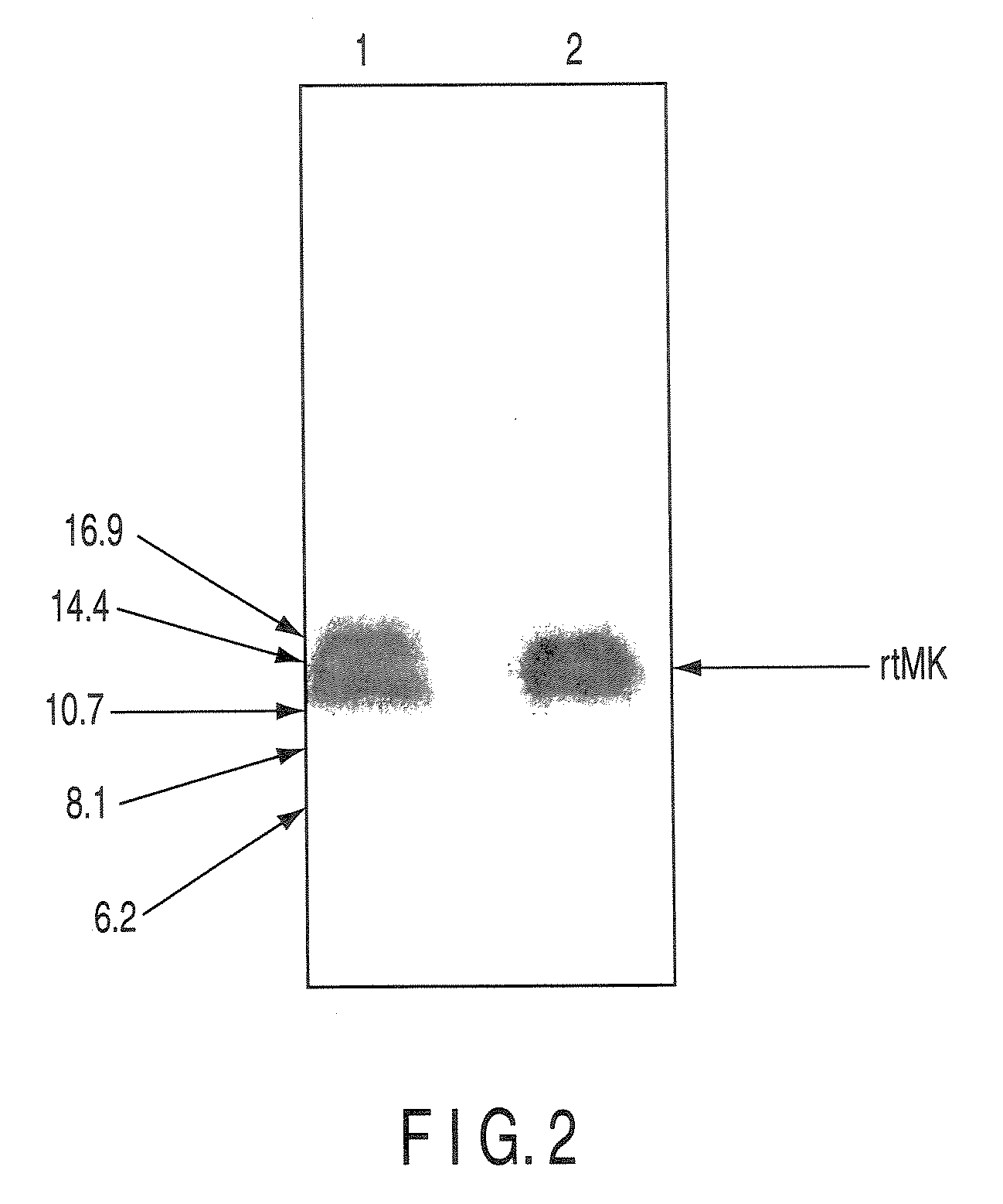Monoclonal antibody specific to truncated midkine (TMK) protein and uses thereof
a technology of truncated midkine and monoclonal antibody, which is applied in the field of monoclonal antibody specific to truncated midkine (tmk) protein, can solve the problems of inability to detect tmk protein, inability to confirm the presence of tmk protein, and difficulty in diagnosis
- Summary
- Abstract
- Description
- Claims
- Application Information
AI Technical Summary
Problems solved by technology
Method used
Image
Examples
example 1
[Example 1] Preparation of Recombinant tMK Protein
[0056] On the basis of information of tMKmRNA [T. Kaname et al., Biochemical and Biophysical Research Communications vol. 219, pp. 256-260 (1996)], four amino acids, Met-Lys-Lys-Lys, were additionally introduced into the N-terminal of the amino acid sequence (60-121 amino acids) of a human MK fragment to construct a tMK expression plasmid. First, a plasmid vector (pUC118-MK vector) containing the MK sequence was subjected to PCR using a sense primer: 5′-GCC CAT GGG GATGAA AAA GAA AGC CGA CTG-3′(Sequence No. 1) where the portion of “CC CAT GG” is an NcoI restriction-enzyme recognition site, an antisense primer: 5′-CCC AAG CTT AGT CCT TTC CCT TCC CTT TCT-3′(Sequence No. 2) where a portion of “AAG CTT” is a Hind III restriction enzyme recognition site. In this manner, a DNA fragment encoding tMK protein was obtained. The PCR cycle (94° C. for one minute, 55° C. for one minute and 72° C. for 30 minutes) was repeated 30 times. The sequenc...
example 2
[Example 2] Preparation of Anti-tMK Specific antibody
[0059] (1) Preparation of anti-tMK specific antibody producing cell
[0060] First, 7 week-old BALB / C line female mouse was immunized by administering the recombinant tMK protein prepared in Example 1 as an antigen every two weeks, three times in total. The first and second immunization, Freund's complete adjuvant (FCA) and Freund's incomplete adjuvant (FICA) were mixed in an equal amount, emulsified, and subcutaneously administered to the mouse. In the third immunization, the same amount of antigen as those of the first and second immunization was injected through the tail vein. At the third day after the final immunization, the spleen cells were fused with mouse myeloma cells P3X63-AG8.653 in a ratio of 5:1 by use of PEG and cultured in HAT selective medium to select hybridoma cells alone. The obtained hybridoma cells were seeded to 96 wells of a microplate (0.5 cell / well) in accordance with the limiting dilution analysis. Thereaf...
example 3
[0064] Detection of tMK in tumor cells by Western blotting
[0065] (1) Preparation of G401 cell supernatant
[0066] The Wilms' tumor derived G401 cells were cultured in a 90-mm petri dish containing McCoy's 5A medium supplemented with a 10% FBS up to confluent. The culture supernatant was purified by a Haparin-Sepharose column.
[0067] (2) Detection of tMK from G401 cell culture supernatant By ELISA
[0068] The supernatant obtained in Section (1) was fixed to a 96-well plate for ELISA. Anti-tMK-MiStMK-V3 antibody was dispensed to individual wells as a primary antibody. As a control, anti-Mk antibody was used. These antibodies were incubated and washed and subsequently POD labeled anti-mouse IgG and POD labeled anti-rat IgG serving as a secondary antibody were dispensed and incubated. After washing, ABTS was added as a color-producing substrate and the absorbancy at 415 nm was determined. The results are shown in Table 2. As is apparent from Table 2, the presence of tMK was determined in...
PUM
| Property | Measurement | Unit |
|---|---|---|
| volume | aaaaa | aaaaa |
| temperature | aaaaa | aaaaa |
| pH | aaaaa | aaaaa |
Abstract
Description
Claims
Application Information
 Login to View More
Login to View More - R&D
- Intellectual Property
- Life Sciences
- Materials
- Tech Scout
- Unparalleled Data Quality
- Higher Quality Content
- 60% Fewer Hallucinations
Browse by: Latest US Patents, China's latest patents, Technical Efficacy Thesaurus, Application Domain, Technology Topic, Popular Technical Reports.
© 2025 PatSnap. All rights reserved.Legal|Privacy policy|Modern Slavery Act Transparency Statement|Sitemap|About US| Contact US: help@patsnap.com



